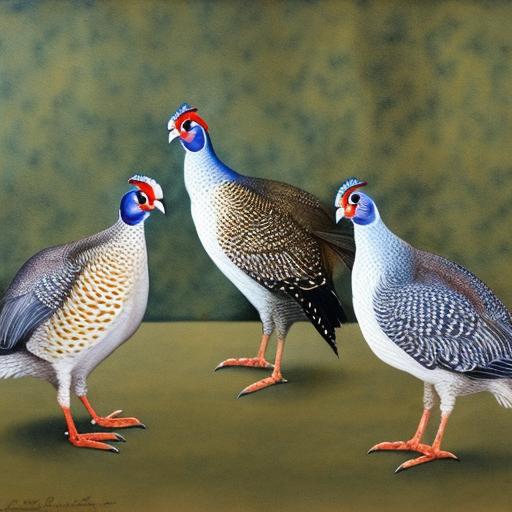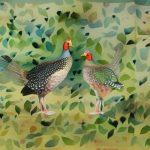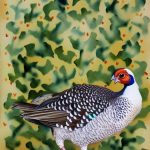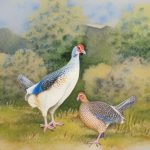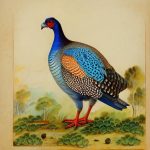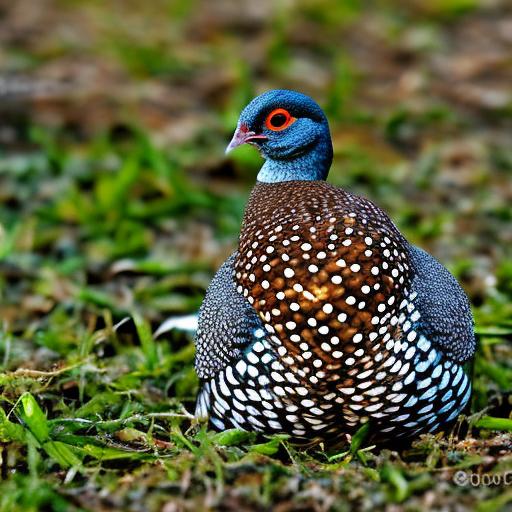Pearl Grey Guinea Fowl, also known as the Lavender Guinea Fowl, is a unique and beautiful breed of domesticated bird that is popular among poultry enthusiasts. These birds are native to West Africa and have been domesticated for centuries. They are known for their striking appearance, with a pearl grey plumage that has a subtle lavender hue. Pearl Grey Guinea Fowl are not only valued for their beauty, but also for their practical uses on the farm. They are excellent foragers and are often kept for pest control, as they have a voracious appetite for insects and ticks. In addition, they are also raised for their flavorful meat and nutritious eggs. Pearl Grey Guinea Fowl are relatively low-maintenance and hardy birds, making them a great addition to any farm or homestead.
Pearl Grey Guinea Fowl are a popular breed among poultry enthusiasts due to their unique appearance and practical uses on the farm. These birds are native to West Africa and have been domesticated for centuries. They are known for their striking pearl grey plumage with a subtle lavender hue. In addition to their beauty, Pearl Grey Guinea Fowl are valued for their practical uses on the farm. They are excellent foragers and are often kept for pest control, as they have a voracious appetite for insects and ticks. Furthermore, they are also raised for their flavorful meat and nutritious eggs. Pearl Grey Guinea Fowl are relatively low-maintenance and hardy birds, making them a great addition to any farm or homestead.
Key Takeaways
- Pearl Grey Guinea Fowl are a popular breed known for their unique coloration and hardiness
- They have a distinct appearance with a pearl grey plumage and a small, round head
- Pearl Grey Guinea Fowl are known for being active, alert, and social birds
- They require a secure and spacious coop with access to outdoor space for foraging
- Breeding Pearl Grey Guinea Fowl can be a rewarding experience, and they are valued for their pest control abilities and flavorful meat
Physical Characteristics of Pearl Grey Guinea Fowl
Pearl Grey Guinea Fowl are medium-sized birds with a distinctive appearance. They have a compact, muscular body with a small head and a short, curved beak. Their most striking feature is their plumage, which is a beautiful pearl grey color with a subtle lavender hue. The feathers have a unique pattern of white spots, giving the birds a speckled appearance. The legs and feet of Pearl Grey Guinea Fowl are a dark slate color, and they have sharp claws that are well-suited for scratching and foraging. The birds have a small, rounded crest on top of their heads, which adds to their regal and elegant appearance. Overall, Pearl Grey Guinea Fowl are known for their striking beauty and unique plumage, making them a popular choice for poultry enthusiasts.
Pearl Grey Guinea Fowl are medium-sized birds with a distinctive appearance. They have a compact, muscular body with a small head and a short, curved beak. Their most striking feature is their plumage, which is a beautiful pearl grey color with a subtle lavender hue. The feathers have a unique pattern of white spots, giving the birds a speckled appearance. The legs and feet of Pearl Grey Guinea Fowl are a dark slate color, and they have sharp claws that are well-suited for scratching and foraging. The birds have a small, rounded crest on top of their heads, which adds to their regal and elegant appearance. Overall, Pearl Grey Guinea Fowl are known for their striking beauty and unique plumage, making them a popular choice for poultry enthusiasts.
Behavior and Temperament of Pearl Grey Guinea Fowl
Pearl Grey Guinea Fowl are known for their active and alert nature. They are highly social birds that thrive in flocks, and they are often seen foraging together in search of food. These birds are excellent foragers and have a keen eye for spotting insects and other small prey. They are also known for their loud and distinctive calls, which serve as an effective alarm system to alert the flock of potential danger. Pearl Grey Guinea Fowl are generally docile and friendly towards humans, especially if they are raised from a young age and handled regularly. However, they can be skittish and easily startled, so it is important to provide them with a secure and safe environment. Overall, Pearl Grey Guinea Fowl are active, social birds with a keen sense of awareness and an endearing personality.
Pearl Grey Guinea Fowl are known for their active and alert nature. They are highly social birds that thrive in flocks, and they are often seen foraging together in search of food. These birds are excellent foragers and have a keen eye for spotting insects and other small prey. They are also known for their loud and distinctive calls, which serve as an effective alarm system to alert the flock of potential danger. Pearl Grey Guinea Fowl are generally docile and friendly towards humans, especially if they are raised from a young age and handled regularly. However, they can be skittish and easily startled, so it is important to provide them with a secure and safe environment. Overall, Pearl Grey Guinea Fowl are active, social birds with a keen sense of awareness and an endearing personality.
Housing and Care for Pearl Grey Guinea Fowl
When it comes to housing Pearl Grey Guinea Fowl, it is important to provide them with a secure and spacious coop or shelter. These birds are active foragers and require plenty of space to roam and explore. The coop should be well-ventilated and provide protection from predators such as foxes, raccoons, and birds of prey. It is also important to provide roosting perches inside the coop to give the birds a place to rest at night. In addition, Pearl Grey Guinea Fowl require access to fresh water at all times, as well as a balanced diet of poultry feed supplemented with greens and insects. It is important to regularly clean the coop to maintain good hygiene and prevent the spread of disease. Overall, providing a safe and comfortable living environment is essential for the health and well-being of Pearl Grey Guinea Fowl.
When it comes to housing Pearl Grey Guinea Fowl, it is important to provide them with a secure and spacious coop or shelter. These birds are active foragers and require plenty of space to roam and explore. The coop should be well-ventilated and provide protection from predators such as foxes, raccoons, and birds of prey. It is also important to provide roosting perches inside the coop to give the birds a place to rest at night. In addition, Pearl Grey Guinea Fowl require access to fresh water at all times, as well as a balanced diet of poultry feed supplemented with greens and insects. It is important to regularly clean the coop to maintain good hygiene and prevent the spread of disease. Overall, providing a safe and comfortable living environment is essential for the health and well-being of Pearl Grey Guinea Fowl.
Breeding and Reproduction of Pearl Grey Guinea Fowl
Breeding Pearl Grey Guinea Fowl can be a rewarding experience for poultry enthusiasts. These birds reach sexual maturity at around six months of age, at which point they will begin to display courtship behaviors such as strutting and calling. To encourage successful breeding, it is important to provide the birds with a comfortable nesting area that is secluded and protected from disturbances. The female will lay her eggs in the nest over the course of several days before she begins incubating them. Pearl Grey Guinea Fowl are known for being good mothers, as they will diligently care for their eggs until they hatch. The chicks are precocial and will be able to walk and feed themselves shortly after hatching. Overall, breeding Pearl Grey Guinea Fowl requires careful planning and attention to ensure the health and well-being of the birds and their offspring.
Breeding Pearl Grey Guinea Fowl can be a rewarding experience for poultry enthusiasts. These birds reach sexual maturity at around six months of age, at which point they will begin to display courtship behaviors such as strutting and calling. To encourage successful breeding, it is important to provide the birds with a comfortable nesting area that is secluded and protected from disturbances. The female will lay her eggs in the nest over the course of several days before she begins incubating them. Pearl Grey Guinea Fowl are known for being good mothers, as they will diligently care for their eggs until they hatch. The chicks are precocial and will be able to walk and feed themselves shortly after hatching. Overall, breeding Pearl Grey Guinea Fowl requires careful planning and attention to ensure the health and well-being of the birds and their offspring.
Uses and Benefits of Pearl Grey Guinea Fowl

Pearl Grey Guinea Fowl have several practical uses on the farm that make them valuable additions to any poultry flock. One of their primary benefits is their ability to control pests such as insects, ticks, and small rodents. These birds have voracious appetites for pests and will actively seek them out while foraging, helping to keep pest populations in check without the need for chemical pesticides. In addition to pest control, Pearl Grey Guinea Fowl are also raised for their flavorful meat, which is lean and rich in protein. Their eggs are also prized for their nutritional value, as they contain higher levels of protein and essential nutrients compared to chicken eggs. Furthermore, these birds can also serve as effective alarm systems due to their loud calls, alerting farmers to potential threats or intruders on the property. Overall, Pearl Grey Guinea Fowl offer a range of practical benefits that make them valuable assets on the farm.
Pearl Grey Guinea Fowl have several practical uses on the farm that make them valuable additions to any poultry flock. One of their primary benefits is their ability to control pests such as insects, ticks, and small rodents. These birds have voracious appetites for pests and will actively seek them out while foraging, helping to keep pest populations in check without the need for chemical pesticides. In addition to pest control, Pearl Grey Guinea Fowl are also raised for their flavorful meat, which is lean and rich in protein. Their eggs are also prized for their nutritional value, as they contain higher levels of protein and essential nutrients compared to chicken eggs. Furthermore, these birds can also serve as effective alarm systems due to their loud calls, alerting farmers to potential threats or intruders on the property. Overall, Pearl Grey Guinea Fowl offer a range of practical benefits that make them valuable assets on the farm.
Conclusion and Considerations for Raising Pearl Grey Guinea Fowl
In conclusion, Pearl Grey Guinea Fowl are unique and valuable birds that offer both aesthetic beauty and practical benefits on the farm. Their striking appearance, active nature, and practical uses make them popular among poultry enthusiasts who are looking for an alternative to traditional chicken breeds. When raising Pearl Grey Guinea Fowl, it is important to provide them with a secure living environment that meets their needs for space, protection from predators, fresh water, and a balanced diet. Additionally, careful attention should be given to breeding and reproduction to ensure the health and well-being of the birds and their offspring. With proper care and management, Pearl Grey Guinea Fowl can thrive on the farm while providing valuable pest control services, flavorful meat, nutritious eggs, and an endearing presence that adds charm to any homestead or agricultural operation.
In conclusion, Pearl Grey Guinea Fowl are unique and valuable birds that offer both aesthetic beauty and practical benefits on the farm. Their striking appearance, active nature, and practical uses make them popular among poultry enthusiasts who are looking for an alternative to traditional chicken breeds. When raising Pearl Grey Guinea Fowl, it is important to provide them with a secure living environment that meets their needs for space, protection from predators, fresh water, and a balanced diet. Additionally, careful attention should be given to breeding and reproduction to ensure the health and well-being of the birds and their offspring. With proper care and management, Pearl Grey Guinea Fowl can thrive on the farm while providing valuable pest control services, flavorful meat, nutritious eggs, and an endearing presence that adds charm to any homestead or agricultural operation.
In conclusion, Pearl Grey Guinea Fowl are unique and valuable birds that offer both aesthetic beauty and practical benefits on the farm. Their striking appearance, active nature, and practical uses make them popular among poultry enthusiasts who are looking for an alternative to traditional chicken breeds. When raising Pearl Grey Guinea Fowl, it is important to provide them with a secure living environment that meets their needs for space, protection from predators, fresh water, and a balanced diet. Additionally, careful attention should be given to breeding and reproduction to ensure the health and well-being of the birds and their offspring. With proper care and management, Pearl Grey Guinea Fowl can thrive on the farm while providing valuable pest control services, flavorful meat, nutritious eggs, and an endearing presence that adds charm to any homestead or agricultural operation. Their unique combination of beauty and utility makes them a valuable addition to any farm or homestead.
If you’re interested in raising guinea fowl breeds like the pearl grey variety, you may also want to explore the article on “What Should You Feed Ducks” on PoultryWizard. Understanding the dietary needs of different poultry species is crucial for their health and well-being. Check out the article here to learn more about providing proper nutrition for your ducks.
FAQs
What are the characteristics of Pearl Grey guinea fowl breeds?
Pearl Grey guinea fowl breeds are known for their distinctive pearl grey plumage with white spots. They have a small, round head with a short beak and a prominent bony casque on top of their head. They are medium-sized birds with a compact, muscular build.
What is the temperament of Pearl Grey guinea fowl breeds?
Pearl Grey guinea fowl breeds are known for being alert, active, and highly social birds. They are excellent foragers and are often kept for pest control in gardens and farms. They are also known for their loud, distinctive calls, which serve as a warning signal for potential threats.
What are the ideal living conditions for Pearl Grey guinea fowl breeds?
Pearl Grey guinea fowl breeds thrive in spacious outdoor environments with access to grassy areas for foraging. They require shelter at night to protect them from predators and the elements. They are also known for their ability to roost in trees, so providing them with suitable perches is important.
What is the average lifespan of Pearl Grey guinea fowl breeds?
Pearl Grey guinea fowl breeds have an average lifespan of 10-15 years when kept in suitable living conditions and provided with proper care and nutrition.
What are the dietary needs of Pearl Grey guinea fowl breeds?
Pearl Grey guinea fowl breeds are omnivorous and have a varied diet that includes insects, seeds, grains, and vegetation. They also require access to grit or small stones to aid in the digestion of their food. Additionally, they should have access to fresh, clean water at all times.
Meet Walter, the feathered-friend fanatic of Florida! Nestled in the sunshine state, Walter struts through life with his feathered companions, clucking his way to happiness. With a coop that’s fancier than a five-star hotel, he’s the Don Juan of the chicken world. When he’s not teaching his hens to do the cha-cha, you’ll find him in a heated debate with his prized rooster, Sir Clucks-a-Lot. Walter’s poultry passion is no yolk; he’s the sunny-side-up guy you never knew you needed in your flock of friends!

